First off, many thanks to those who offered feedback on last week’s post, in which I asked for input regarding what I might work on next. I appreciate your thoughts. The general consensus appears to be that there is no general consensus. Several people did express enthusiasm for more Thieftaker and more Justis Fearsson. A number were also interested in reading more in the Radiants supernatural thriller series, and a few fans from way back were excited to see an edited reissue of the Winds of the Forelands books. Others liked the idea of a new writing How-To as well as the space opera concept. Which is to say, there was at least some support for pretty much everything I’m currently considering, and that’s reassuring.
We are nearing the end of October, which means Halloween is almost here, elections are right around the corner, and NaNoWriMo is about to start. For those unfamiliar with the term, National Novel Writing Month began in November 1999 as a challenge to writers to write 50,000 words in thirty days. The challenge has grown in popularity each year, and now engages literally hundreds of thousands of writers, including kids, in creative writing. NaNoWriMo is also a non-profit that promotes literacy and creativity.
In many ways, NaNo is a positive force in our industry. It fosters community, by bringing together writers of different backgrounds and abilities in a simultaneous effort to be creative on demand. And as I have said in this space again and again, part of being a professional writer is learning how to produce on demand, without “waiting for the muse,” or some such. I have heard many stories of people finally being motivated to write by NaNo, by the communal aspect of the challenge. Knowing others are making the effort at the same time enables some people to write the story that has been burning inside them for so, so long. I think that’s great.
And yet . . . . From the time NaNo first began, I have had some qualms about the concept and the structure. I have written 50,000 words in a month; I’ve done it a couple of times. I know some professionals who write far more than that in 30 days. It can be done, no doubt. And if the challenge and group dynamics of NaNo get your creative juices flowing, more power to you.
But what I remember about those occasional months during which I churned out 50,000 words is that I was unable to sustain the effort. Each time, during the month that followed, I struggled to write half as much. I was burnt out. I know some people have gone on to publish novels they began during a NaNo November. But I wonder how many NaNo participants still have novel fragments of 50,000 words (or 40,000, or 30,000) on their computers, gathering virtual dust. I wonder how many did NaNo only to find themselves unable to sustain the effort beyond the month in question.
As I said, professionals, myself included, can and do write half a novel in a month’s time, but most of us write slower than that. My brother is a visual artist, a painter. And he will occasionally engage in exercises that force him to paint quickly. There is something freeing about turning off the inner critic and just painting fast, to see how an image turns out. Just as there is something freeing about blocking out our inner editor and writing swiftly and in volume. Most of the time, though, my brother’s process looks nothing like that. And I can promise you my writing process — and that of most of my professional colleagues — bears little or no resemblance to NaNo.
Yes, NaNo can jumpstart the creative process for some people, but I would offer this: If instead of trying to write 50,000 words in thirty days, an aspiring writer were to try to write 500 words a day for 100 days, that writer would wind up with the same volume. Yes, it would take more time, but in the snail’s-pace world of publishing the difference between one month and three isn’t so great. Plus, I guarantee you, the 50,000 word manuscript produced over three months will be far, far cleaner than the NaNo manuscript and will require a good deal less editing, thus narrowing the time gap.
Most importantly, while NaNo will leave many writers exhausted and unprepared to follow up and finish the manuscript in question, the 500-word-a-day writer will have developed a habit, a creative routine that is both manageable and sustainable. More than likely, that writer will be able to increase their production over those three months and beyond.
I’m not looking for a fight here, and again, if NaNo works for you, go for it. Enjoy yourself. But if you have considered NaNo, wondering if you might finally kick off a writing career by trying it, I would encourage you to try the slow-and-steady approach instead. As a model, it is much closer to the professional experience than NaNo will ever be and, to my mind, it is more likely to produce a) clean prose, b) a coherent narrative, and c) a completed manuscript.
Whatever you decide, keep writing!









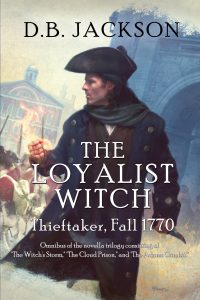 One idea is to write my next Thieftaker novel, either in the form of a trio of novellas, like I did with
One idea is to write my next Thieftaker novel, either in the form of a trio of novellas, like I did with 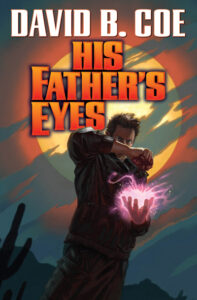
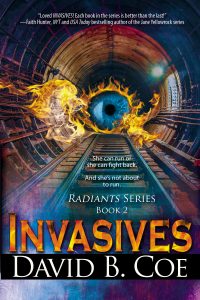 I want to write at least one more
I want to write at least one more 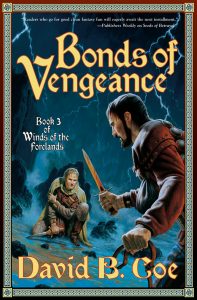 Many years back, while I was working on one of the middle books in my Winds of the Forelands quintet, my second series, I came downstairs after a particularly frustrating day of writing and started whining to Nancy about my manuscript. It was terrible, I told her. There was no story there, no way to complete the narrative I’d begun. The book was a disaster, and I might well have to scrap the whole thing.
Many years back, while I was working on one of the middle books in my Winds of the Forelands quintet, my second series, I came downstairs after a particularly frustrating day of writing and started whining to Nancy about my manuscript. It was terrible, I told her. There was no story there, no way to complete the narrative I’d begun. The book was a disaster, and I might well have to scrap the whole thing.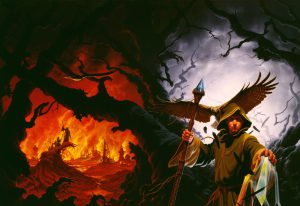 For the Thieftaker novels, Tor hired the incomparable
For the Thieftaker novels, Tor hired the incomparable 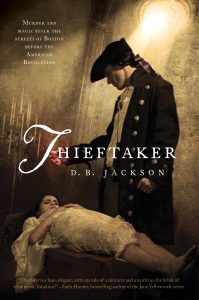 The thing to remember about artwork, though, is that it’s not enough for the covers to be eye-catching. They also need to tell a story — your story. The Thieftaker covers work because they convey the time period, they offer a suggestion of the mystery contained within, and they hint as well at magic, by always including that swirl of conjuring power in Ethan’s hand. The Islevale covers all have that golden timepiece in them, the chronofor, which enables my Walkers to move through time. All my traditional epic fantasy covers, from the LonTobyn books through the Forelands and Southlands series, convey a medieval fantasy vibe. Readers who see those books, even if they don’t know me or my work, will have an immediate sense of the stories contained within.
The thing to remember about artwork, though, is that it’s not enough for the covers to be eye-catching. They also need to tell a story — your story. The Thieftaker covers work because they convey the time period, they offer a suggestion of the mystery contained within, and they hint as well at magic, by always including that swirl of conjuring power in Ethan’s hand. The Islevale covers all have that golden timepiece in them, the chronofor, which enables my Walkers to move through time. All my traditional epic fantasy covers, from the LonTobyn books through the Forelands and Southlands series, convey a medieval fantasy vibe. Readers who see those books, even if they don’t know me or my work, will have an immediate sense of the stories contained within.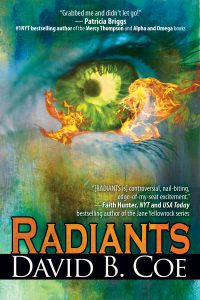 And that’s what we want. Sure, part of what makes that Invasives cover work is the simple fact that it’s stunning. The eye, the flames, the lighting in the tunnel. It’s a terrific image. But it also tells you there is a supernatural story within. And while the tunnel “setting” is unusual, the presence of train tracks, wires, electric wiring, and even that loudspeaker in the upper left quadrant of the tunnel, combine to tell you the story takes place in our world (or something very much like it). And for those who have seen the cover of the first book in the series, Radiants, the eye and flames mark this new book as part of the same franchise. That’s effective packaging.
And that’s what we want. Sure, part of what makes that Invasives cover work is the simple fact that it’s stunning. The eye, the flames, the lighting in the tunnel. It’s a terrific image. But it also tells you there is a supernatural story within. And while the tunnel “setting” is unusual, the presence of train tracks, wires, electric wiring, and even that loudspeaker in the upper left quadrant of the tunnel, combine to tell you the story takes place in our world (or something very much like it). And for those who have seen the cover of the first book in the series, Radiants, the eye and flames mark this new book as part of the same franchise. That’s effective packaging.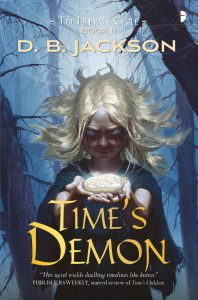 In the same vein, poor marketing practices by a publisher, even if inadvertent, can doom even the most beautiful book. I LOVE the art for Time’s Demon, the second Islevale novel. But the novel came out when the publisher was going through an intense reorganization. It got little or no marketing attention, and despite looking great and being in my view one of the best things I’ve written, it was pretty much the worst-selling book of my career.
In the same vein, poor marketing practices by a publisher, even if inadvertent, can doom even the most beautiful book. I LOVE the art for Time’s Demon, the second Islevale novel. But the novel came out when the publisher was going through an intense reorganization. It got little or no marketing attention, and despite looking great and being in my view one of the best things I’ve written, it was pretty much the worst-selling book of my career.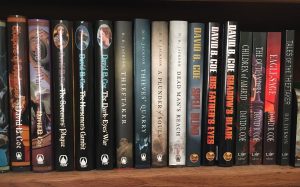 As I mentioned in
As I mentioned in 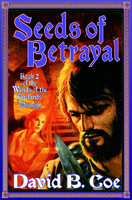
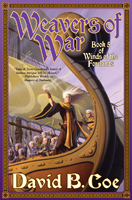 For the Winds of the Forelands series (Rules of Ascension, Seeds of Betrayal, Bonds of Vengeance, Shapers of Darkness, Weavers of War) , I created what is without a doubt the most complex “calendar” I’ve ever undertaken for any project. For those of you not familiar with the world, I’ll give a very brief description. The world has two moons, Ilias and Panya, the Lovers, who chase each other across the sky. Each turn (month) has one night when both moons are full (the Night of Two Moons) and one night when both moons are dark (Pitch Night). Each turn is also named for a god or goddess, and so each Night of Two Moons and each Pitch Night has a special meaning.
For the Winds of the Forelands series (Rules of Ascension, Seeds of Betrayal, Bonds of Vengeance, Shapers of Darkness, Weavers of War) , I created what is without a doubt the most complex “calendar” I’ve ever undertaken for any project. For those of you not familiar with the world, I’ll give a very brief description. The world has two moons, Ilias and Panya, the Lovers, who chase each other across the sky. Each turn (month) has one night when both moons are full (the Night of Two Moons) and one night when both moons are dark (Pitch Night). Each turn is also named for a god or goddess, and so each Night of Two Moons and each Pitch Night has a special meaning.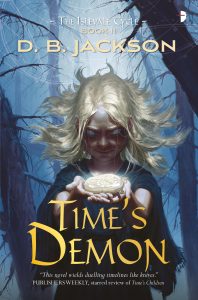 I did something similar for the Islevale Cycle novels (Time’s Children, Time’s Demon, Time’s Assassin). In this world there are two primary deities, Kheraya (female) and Sipar (male), and the calendar is structured around them. It begins with the spring equinox — Kheraya’s Emergence, a day and night of enhanced magickal power and sensuality. The spring months are known as Kheraya’s Stirring, Kheraya’s Waking, Kheraya’s Ascent. The summer solstice is called Kheraya Ascendent, a day of feasts, celebration, and gift-giving. This is followed by the hot months of summer: Kheraya’s Descent, Fading, and Settling.
I did something similar for the Islevale Cycle novels (Time’s Children, Time’s Demon, Time’s Assassin). In this world there are two primary deities, Kheraya (female) and Sipar (male), and the calendar is structured around them. It begins with the spring equinox — Kheraya’s Emergence, a day and night of enhanced magickal power and sensuality. The spring months are known as Kheraya’s Stirring, Kheraya’s Waking, Kheraya’s Ascent. The summer solstice is called Kheraya Ascendent, a day of feasts, celebration, and gift-giving. This is followed by the hot months of summer: Kheraya’s Descent, Fading, and Settling.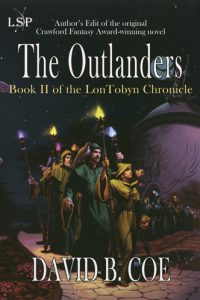 The second book, in contrast, was very much a product of its time, and I mean that in a couple of ways. In that book, The Outlanders, my heroes, Jaryd and Alayna are building a life together and starting a family, just as Nancy and I were starting our own family. When writing in book III, Eagle-Sage, about their young daughter, I drew extensively on our experience raising our first child. And in book II, when Niall lost his wife to cancer, I drew upon the experience of watching my father deal with my mother’s death.
The second book, in contrast, was very much a product of its time, and I mean that in a couple of ways. In that book, The Outlanders, my heroes, Jaryd and Alayna are building a life together and starting a family, just as Nancy and I were starting our own family. When writing in book III, Eagle-Sage, about their young daughter, I drew extensively on our experience raising our first child. And in book II, when Niall lost his wife to cancer, I drew upon the experience of watching my father deal with my mother’s death.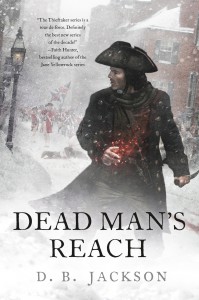 Still, I can say this: It’s easy to grow attached to one particular franchise, one particularly world and set of characters and style of story. Certainly I have written a good deal in the Thieftaker world, and will soon be coming out with new work about Ethan Kaille, Sephira Pryce, et al. The fact is, though, each time I have moved on to a new project, I have tried (admittedly with varying degrees of success) to challenge myself, to force myself to grow.
Still, I can say this: It’s easy to grow attached to one particular franchise, one particularly world and set of characters and style of story. Certainly I have written a good deal in the Thieftaker world, and will soon be coming out with new work about Ethan Kaille, Sephira Pryce, et al. The fact is, though, each time I have moved on to a new project, I have tried (admittedly with varying degrees of success) to challenge myself, to force myself to grow.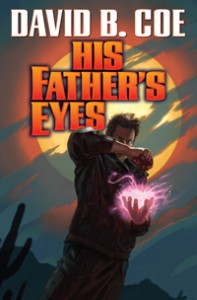 After the LonTobyn books, I moved to Winds of the Forelands and Blood of the Southlands, which demanded far more sophisticated world building and character work. After those, I turned to Thieftaker, adding historical and mystery elements to my storytelling and limiting my point of view to a single character. I also started working on the Justis Fearsson books, which explored mental health issues and were my first forays into writing in a contemporary setting. Then I took on the Islevale books, time travel/epic fantasies that presented the most difficult plotting issues I’ve ever faced.
After the LonTobyn books, I moved to Winds of the Forelands and Blood of the Southlands, which demanded far more sophisticated world building and character work. After those, I turned to Thieftaker, adding historical and mystery elements to my storytelling and limiting my point of view to a single character. I also started working on the Justis Fearsson books, which explored mental health issues and were my first forays into writing in a contemporary setting. Then I took on the Islevale books, time travel/epic fantasies that presented the most difficult plotting issues I’ve ever faced.